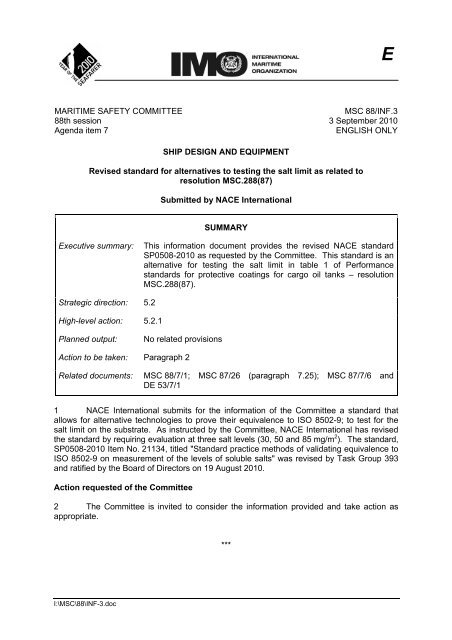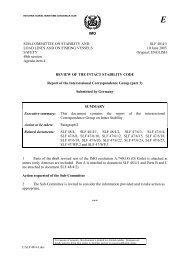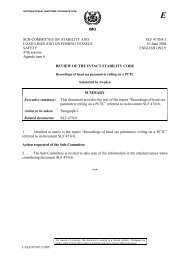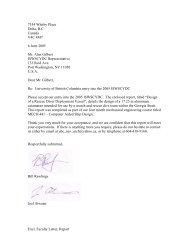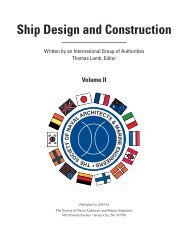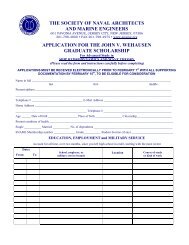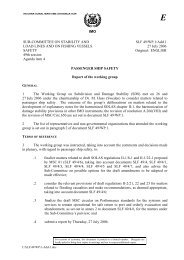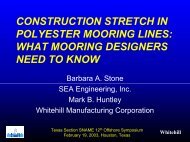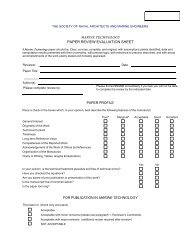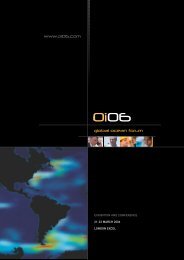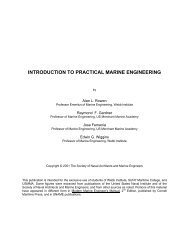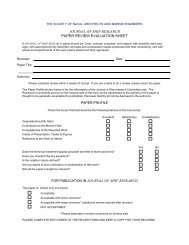MSC 88/Inf.3 - SNAME.org
MSC 88/Inf.3 - SNAME.org
MSC 88/Inf.3 - SNAME.org
You also want an ePaper? Increase the reach of your titles
YUMPU automatically turns print PDFs into web optimized ePapers that Google loves.
E<br />
MARITIME SAFETY COMMITTEE<br />
<strong>88</strong>th session<br />
Agenda item 7<br />
<strong>MSC</strong> <strong>88</strong>/INF.3<br />
3 September 2010<br />
ENGLISH ONLY<br />
SHIP DESIGN AND EQUIPMENT<br />
Revised standard for alternatives to testing the salt limit as related to<br />
resolution <strong>MSC</strong>.2<strong>88</strong>(87)<br />
Submitted by NACE International<br />
SUMMARY<br />
Executive summary:<br />
This information document provides the revised NACE standard<br />
SP0508-2010 as requested by the Committee. This standard is an<br />
alternative for testing the salt limit in table 1 of Performance<br />
standards for protective coatings for cargo oil tanks – resolution<br />
<strong>MSC</strong>.2<strong>88</strong>(87).<br />
Strategic direction: 5.2<br />
High-level action: 5.2.1<br />
Planned output:<br />
No related provisions<br />
Action to be taken: Paragraph 2<br />
Related documents:<br />
<strong>MSC</strong> <strong>88</strong>/7/1; <strong>MSC</strong> 87/26 (paragraph 7.25); <strong>MSC</strong> 87/7/6 and<br />
DE 53/7/1<br />
1 NACE International submits for the information of the Committee a standard that<br />
allows for alternative technologies to prove their equivalence to ISO 8502-9; to test for the<br />
salt limit on the substrate. As instructed by the Committee, NACE International has revised<br />
the standard by requiring evaluation at three salt levels (30, 50 and 85 mg/m 2 ). The standard,<br />
SP0508-2010 Item No. 21134, titled "Standard practice methods of validating equivalence to<br />
ISO 8502-9 on measurement of the levels of soluble salts" was revised by Task Group 393<br />
and ratified by the Board of Directors on 19 August 2010.<br />
Action requested of the Committee<br />
2 The Committee is invited to consider the information provided and take action as<br />
appropriate.<br />
***<br />
I:\<strong>MSC</strong>\<strong>88</strong>\INF-3.doc
<strong>MSC</strong> <strong>88</strong>/INF.3<br />
Annex, page 1<br />
ANNEX<br />
NACE SP0508-2010<br />
Item No. 21134<br />
METHODS OF VALIDATING EQUIVALENCE TO ISO 8502-9<br />
ON MEASUREMENT OF THE LEVELS OF SOLUBLE SALTS<br />
This NACE International standard represents a consensus of those individual members who have<br />
reviewed this document, its scope, and provisions. Its acceptance does not in any respect preclude<br />
anyone, whether he or she has adopted the standard or not, from manufacturing, marketing,<br />
purchasing, or using products, processes, or procedures not in conformance with this standard.<br />
Nothing contained in this NACE International standard is to be construed as granting any right, by<br />
implication or otherwise, to manufacture, sell, or use in connection with any method, apparatus, or<br />
product covered by Letters patent, or as indemnifying ore protecting anyone against liability for<br />
infringement of Letters Patent. This standard represents minimum requirements and should in no way<br />
be interpreted as a restriction on the use of better procedures or materials. Neither is this standard<br />
intended to apply in all cases relating to the subject. Unpredictable circumstances may negate the<br />
usefulness of this standard in specific instances. NACE International assumes no responsibility for<br />
the interpretation or use of this standard by other parties and accepts responsibility for only those<br />
official NACE International interpretations issued by NACE International in accordance with its<br />
governing procedures and policies which preclude the issuance of interpretations by individual<br />
volunteers.<br />
Users of this NACE international standard are responsible for reviewing appropriate health, safety,<br />
environmental, and regulatory documents and for determining their applicability in relation to this<br />
standard prior to its use. This NACE International standard may not necessarily address all potential<br />
health and safety problems or environmental hazards associated with the use of materials, equipment,<br />
and/or operations detailed or referred to within this standard. Users of this NACE International<br />
standard are also responsible for establishing appropriate health, safety, and environmental protection<br />
practices, in consultation with appropriate regulatory authorities if necessary, to achieve compliance<br />
with any existing applicable regulatory requirements prior to the use of this standard.<br />
CAUTIONARY NOTICE: NACE international standards are subject to periodic review, and may be<br />
revised or withdrawn at any time in accordance with NACE technical committee procedures. NACE<br />
International requires that action be taken to reaffirm, revise, or withdraw this standard no later than<br />
five years from the date of initial publication. The user is cautioned to obtain the latest edition.<br />
Purchasers of NACE International standards may receive current information on all standards and<br />
other NACE International publications by contacting the NACE International FirstService Department,<br />
1440 South Creek Dr., Houston, Texas 77084-4907 (telephone +1 281-228-6200).<br />
Revised 2010-08-19<br />
Approved 2008-11-07<br />
NACE International<br />
1440 South Creek Dr.<br />
Houston, Texas 77084-4906<br />
+1 281-228-6200<br />
ISBN 1-57590-222-2<br />
© 2010, NACE International<br />
I:\<strong>MSC</strong>\<strong>88</strong>\INF-3.doc
SP0508-2010<br />
Foreword<br />
The purpose of this standard practice is to define a method that shows equivalence of other<br />
methods for measuring the level of contamination of soluble salts on surfaces to the Bresle<br />
patch method defined by ISO (1) 8502-9. This standard practice provides a way to establish<br />
equivalence by testing and comparing results of the tests to meet established criteria that<br />
would be achieved using the method specified in ISO 8502-9. Equivalence is evaluated at<br />
three salt levels (30 mg/m 2 , 50 mg/m 2 , and 85 mg/m 2 ) on three surface conditions<br />
(grit blasted steel, zinc silicate preconstruction primer on steel, and rusted steel).<br />
This standard is intended for use by engineers, specification writers, test equipment<br />
suppliers, contractors, and anyone testing for soluble salts on surfaces using ISO 8502-9<br />
and considering use of equivalent methods for this purpose. It provides a standard method<br />
to show such equivalence to the results obtained using ISO 8502-9.<br />
The definition of equivalence as used in this standard is "an alternative tool, method, or<br />
procedure that predictably and reliably provides the same measurement values as testing in<br />
full accordance with ISO 8502-9 would provide under the same circumstances, i.e., that<br />
measures the total salt contamination amount at an extraction rate equal to the method<br />
given in ISO 8502-9, and presents the result as total surface density of the salts as<br />
described in ISO 8502-9, expression of results, and accuracy of the determination."<br />
The validation of the equivalence of a method must be made in a laboratory.<br />
This standard was originally issued in 2008 and revised in 2010 by Task Group (TG) 392,<br />
"Measurement of Soluble Salts on Marine Structures." TG 392 is administered by Specific<br />
Technology Group (STG) 44, "Marine Corrosion: Ships and Structures," and sponsored by<br />
STG 04, "Coatings and Linings, Protective: Surface Preparation." It is issued by<br />
NACE International under the auspices of STG 44.<br />
In NACE standards, the terms shall, must, should, and may are used in accordance with the<br />
definitions of these terms in the NACE Publications Style Manual. The terms shall and must<br />
are used to state a requirement, and are considered mandatory. The term should is used to<br />
state something good and is recommended, but is not considered mandatory. The term may<br />
is used to state something considered optional.<br />
____________________________<br />
(1) International Organization for Standardization (ISO), 1 ch. de la Voie-Creuse, Case postale 56, CH-1211<br />
Geneva 20, Switzerland.<br />
I:\<strong>MSC</strong>\<strong>88</strong>\INF-3.doc
SP0508-2010<br />
NACE International<br />
Standard practice<br />
Methods of validating equivalence to ISO 8502-9<br />
on measurement of the levels of soluble salts<br />
Contents<br />
1. General ................................................................................................................. 1<br />
2. Test Methods ...................................................................................................... 2<br />
3. Reporting .............................................................................................................. 6<br />
References .................................................................................................................... 7<br />
Appendix A: Standard Method for Performance of Soluble Salts Testing in<br />
Accordance with ISO 8502-9 (Mandatory) .............................................. 8<br />
Appendix B: Rationale for Specification Limits (Nonmandatory) ............................... 12<br />
Appendix C: Recommended Preparation of Test Panels and Methods for<br />
Applying Salt Solution to Test Panels (Nonmandatory) ........................ 14<br />
Figures:<br />
Figure A1: Peeling Bresle Patch ............................................................................. 9<br />
Figure A2: Pressing Bresle Patch ........................................................................... 9<br />
Figure A3: Filled Syringe ......................................................................................... 9<br />
Figure A4: Inserting Syringe Needle into Patch ................................................... 10<br />
Figure A5: Rubbing Bresle Patch.......................................................................... 10<br />
Figure A6: Reading Conductivity .......................................................................... 10<br />
________________________________________________________________________<br />
I:\<strong>MSC</strong>\<strong>88</strong>\INF-3.doc
<strong>MSC</strong> <strong>88</strong>/INF.3<br />
Annex, page 1<br />
1.1 ISO 8502-9 - range of variance<br />
SECTION 1: GENERAL<br />
1.1.1 The assessment and determination of surface contamination (by salts) prior to application of<br />
protective coatings is critical to their service life expectancy. Determination of the level of surface<br />
cleanliness is performed using a field method for the conductometric determination of water-soluble<br />
salts in accordance with ISO 8502-9. As a part of that method, the extraction of soluble salt<br />
contaminants for analysis is performed in accordance with ISO 8502-6—the Bresle method. The<br />
field execution of this method involves using a syringe to inject deionized water into the Bresle patch,<br />
washing the substrate surface inside the patch, then extracting the test water for direct measurement<br />
of conductivity. Details of this procedure are provided in Appendix A (mandatory). Once a<br />
conductivity value is determined by the conductivity meter, expressed as microsiemens per<br />
centimeter (μS/cm), ISO 8502-9 provides a procedure to calculate the equivalent mass of the surface<br />
concentration as total surface density of the salts.<br />
1.1.2 Step-by-step execution of the ISO 8502-6 and ISO 8502-9 test methods introduces a<br />
number of potential variances during the field evaluation. Some examples include background salt<br />
contamination in the Bresle patch itself, the sensitivity and resolution of the conductivity meter, cycle<br />
time of the test water inside the Bresle patch, human errors in measuring and injecting the test water,<br />
and general operator experience. These individual process variances combine to create an overall<br />
variance in the ISO 8502-9 test method.<br />
1.1.3 The test method defined in ISO 8502-9 allows certain execution parameters of the test<br />
(e.g., size of adhesive patch, volume of test solution, and time of dissolution of salts inside the<br />
adhesive patch—the dwell time) to vary. This standard adopted best practices and has set the<br />
parameters in Appendix A. With a dwell time at a minimum of 90 seconds, the variance from<br />
operator error was found to be reduced dramatically when the operator timing is not perfect. Hence,<br />
a dwell time of 90 seconds was adopted in Appendix A. For the purpose of defining equivalence, the<br />
procedure in Appendix A shall be used to create the reference values to which the candidate method<br />
will be validated.<br />
1.1.4 Bresle patches from different manufacturers or manufacturing lots may have different levels<br />
of background contamination. Specifications for salt contamination include the contribution of this<br />
background contamination so that the operator in the field does not have to subtract a background<br />
value to report the test results. Appendix A therefore includes a provision to correct the ISO 8502-9<br />
test results to a consistent offset contributed by Bresle patch background contamination so that this<br />
standard gives consistent results when tests are performed with Bresle patches from different<br />
manufacturers or manufacturing lots.<br />
1.1.5 The range of variance in ISO 8502-6 and 8502-9 has been demonstrated by extensive<br />
laboratory tests. The precision of a single ISO 8502-9 test result was determined to be ± 8.2 mg/m 2<br />
in the salt level range of 30 to 80 mg/m 2 . The absolute variance, and not the relative or percent<br />
variance, was found to be constant in this range. See Appendix B (nonmandatory) for details about<br />
these tests and the data analysis.<br />
1.1.6 Any equivalent tools, methods, or procedures must show that they meet the same criteria,<br />
thereby providing the same measures of soluble salt level, and be within the same range of variance,<br />
as would be produced by following the procedure in ISO 8502-9.<br />
1.1.7 The objective of this standard is to determine whether methods other than the Bresle<br />
method are suitable alternatives for measuring salt contamination in the field. Although tests may be<br />
performed on flat, horizontal surfaces for ease of use, each method should also be capable of<br />
performing measurements on vertical and overhead surfaces. When such measurements cannot be<br />
I:\<strong>MSC</strong>\<strong>88</strong>\INF-3.doc
<strong>MSC</strong> <strong>88</strong>/INF.3<br />
Annex, page 2<br />
performed on vertical or overhead surfaces, this limitation must be noted in the validation report<br />
(Section 3).<br />
1.2 Reasons for salt measurement<br />
1.2.1 It is well known that applying protective coatings over salt contamination may cause<br />
degradation of the coating/substrate interface. This may lead to corrosion of the substrate and<br />
detachment of the coating. These effects reduce the expected service life of the coating.<br />
1.2.2 Different salt ions influence the rate of corrosion under coatings differently. However, most<br />
common salts promote corrosion and have a negative effect on the service life of coatings.<br />
1.2.3 Salts on a surface under a coating can create an osmotic cell, drawing water into and<br />
through the coating. The osmotic pressure generated can cause blisters to form in the coating.<br />
1.2.4 The general relationship between the amount of salt contamination under the coating film<br />
and consequent deterioration of the performance may be considered to be linear.<br />
1.2.5 Although virtually unobtainable, a zero measure of salt contamination may be considered<br />
the only "safe" level before application of coating films. Therefore, the maximum quantity of salt<br />
contamination allowed in a specification should be based on a holistic risk/cost analysis.<br />
2.1 Test considerations<br />
SECTION 2: TEST METHODS<br />
2.1.1 For the purposes of this standard, all references to performing a test by ISO 8502-9 shall<br />
mean performing a test by following the test method in Appendix A.<br />
2.1.2 Alternative test methods may produce raw test results with values that are different from<br />
those produced by ISO 8502-9. It is valid to use a single mathematical correction factor to produce<br />
equivalence of alternative test results to those produced by ISO 8502-9.<br />
2.1.3 Failed measurements may be removed from the data sets that are used for data analysis in<br />
Paragraph 2.4.<br />
2.1.3.1 In this standard, "failed measurement" is defined as a failure of the test method that<br />
can be verified independently of the final test result. For example, ISO 8502-9<br />
failures can include leaking of water from the cell during the test, conductivity meter<br />
failing a conductivity calibration check using a known standard solution, or failure of<br />
the operator to comply with the test method.<br />
2.1.3.2 Data removed from the analysis as a result of failures of this nature must be<br />
documented in the final report, including the reason for deeming them failed<br />
measurements.<br />
2.2 Preparation of test panels<br />
2.2.1 Surface conditions of test panels: laboratory tests shall be performed on carbon steel test<br />
panels (e.g., standard grade copper-free hot-rolled carbon steel in accordance with ASTM (2) A366).<br />
Appendix C (nonmandatory) provides recommendations on the preparation of test panels. Three<br />
surface conditions shall be tested:<br />
(2) ASTM International (ASTM), 100 Barr Harbor Dr., West Conshohocken, PA 19428-2959.<br />
I:\<strong>MSC</strong>\<strong>88</strong>\INF-3.doc
<strong>MSC</strong> <strong>88</strong>/INF.3<br />
Annex, page 3<br />
2.2.1.1 Surface Condition A: zinc shop-primer-coated new steel;<br />
2.2.1.2 Surface Condition B: non-shop-primed steel rusted to rust grade C in accordance<br />
with ISO 8501-1; and<br />
2.2.1.3 Surface Condition C: new steel blasted to Sa 2½ in accordance with ISO 8501-1,<br />
using aluminum oxide to achieve a surface profile of 50 to 75 μm (2.0 to 3.0 mil).<br />
2.2.2 Salt Level: Three target levels of salt contamination shall be tested:<br />
2.2.2.1 30 mg/m 2 ;<br />
2.2.2.2 50 mg/m 2 ; and<br />
2.2.2.3 85 mg/m 2 .<br />
2.2.3 Test condition: A test condition is defined in this standard as a unique combination of<br />
surface condition and salt level. Laboratory tests shall be performed at the five test conditions listed<br />
in Table 1:<br />
Test<br />
Condition<br />
Table 1<br />
Test Conditions<br />
Surface<br />
Condition<br />
Target Salt<br />
Level<br />
(mg/m 2 )<br />
1 A 50<br />
2 B 50<br />
3 C 50<br />
4 C 30<br />
5 C 85<br />
2.2.4 Test panel area required: A sufficient number and area of test panels shall be prepared to<br />
accomplish all the testing required in this standard. The minimum test panel dimensions shall<br />
be 200 x 150 mm (8 x 6 in). No area of test panel may be measured twice for this protocol. Test<br />
panels should be adequately sized to allow performance of the test plan in paragraph 2.3 and the<br />
background contamination testing in paragraph 2.2.6, and to make allowances for the potential of<br />
failed tests and for test panels failing the criteria in Paragraph 2.4.1.<br />
2.2.5 The procedures outlined in paragraphs 2.2.6 through 2.2.8 must be accomplished for each<br />
surface condition listed in paragraph 2.2.1.<br />
2.2.6 Maximum background contamination of test panels: Test panels shall be washed with<br />
deionized water. After drying, five positions shall be randomly assigned for testing. These positions<br />
shall be tested in accordance with ISO 8502-9. If the maximum value of any one test is greater than<br />
18 mg/m 2 , this washing, drying, and testing step shall be repeated.<br />
2.2.7 Salt composition: A solution with the following mass ratio of salts shall be used to dope all<br />
the test panels: 24.3% Na 2 SO 4 , 22.1% NaNO 3 , and 53.6% NaCl. The solvent in the solution shall be<br />
exclusively type II water as defined by ASTM D1193.<br />
I:\<strong>MSC</strong>\<strong>88</strong>\INF-3.doc
<strong>MSC</strong> <strong>88</strong>/INF.3<br />
Annex, page 4<br />
2.2.8 Salt solution shall be distributed on the test panels in a way that will yield test results that<br />
comply with the criteria in paragraphs 2.4.1 and 2.4.2. Appendix C provides recommended methods<br />
for application of salt solution to test panels.<br />
2.3 Test measurements<br />
The following procedures shall be used for test measurements.<br />
2.3.1 Develop a test plan that delivers the following test results, and then perform the tests in<br />
accordance with the test plan.<br />
2.3.1.1 A minimum of 10 test results from the Bresle extraction test method (ISO 8502-9)<br />
at each test condition (see Table 1).<br />
2.3.1.2 A minimum of three test results from the Bresle extraction test method<br />
(ISO 8502-9) for each test panel.<br />
2.3.1.3 A minimum of 20 test results from the candidate method at each test condition (see<br />
Table 1).<br />
2.3.2 Assign positions on the test panels in such a way that the ISO 8502-9 test results are widely<br />
and uniformly distributed across the entire surface of each test panel. Randomly assign the<br />
remaining positions on the test panels to the candidate method.<br />
2.3.3 For each test panel, the first two tests and the last test shall be done using ISO 8502-9.<br />
Any remaining ISO 8502-9 tests, and the candidate method, shall be done in random order.<br />
2.4 Data analysis<br />
2.4.1 Validate the ISO 8502-9 measurement capability and uniformity of salt distribution for each<br />
test panel.<br />
2.4.1.1 Apply the criteria in paragraphs 2.4.1 through 2.4.3 to the ISO 8502-9 test results<br />
of each test panel, one test panel at a time. If a test panel fails any one of the<br />
criteria in paragraphs 2.4.1 through 2.4.3, all test results from that test panel must<br />
be deleted from the data analysis;<br />
2.4.1.2 The difference between the highest and lowest test results shall be less than<br />
12 mg/m 2 ;<br />
2.4.1.3 The average of the test results shall be within ± 5 mg/m 2 of the target salt level for<br />
that test condition (see Table 1); and<br />
2.4.1.4 If test results are deleted because a test panel failed the criteria in<br />
paragraphs 2.4.1 through 2.4.3, the test results used for the data analysis must still<br />
include a minimum of 10 test results from ISO 8502-9 and 20 test results from the<br />
candidate method for each test condition (see Table 1). If the number of test<br />
results falls below the minimum number, an appropriate number of new test panels<br />
must be prepared and tested to add to the data set.<br />
2.4.2 Validate the ISO 8502-9 measurement capability and uniformity of salt distribution for the<br />
data set.<br />
2.4.2.1 The standard deviation of the ISO 8502-9 test results at 50 mg/m 2 (combining test<br />
conditions 1, 2, and 3 in Table 1) shall be less than 5.1 mg/m 2 ;<br />
I:\<strong>MSC</strong>\<strong>88</strong>\INF-3.doc
<strong>MSC</strong> <strong>88</strong>/INF.3<br />
Annex, page 5<br />
2.4.2.2 The standard deviation of the ISO 8502-9 test results at 30 mg/m 2 (test condition 4<br />
in Table 1) shall be less than 5.3 mg/m 2 ;<br />
2.4.2.3 The standard deviation of the ISO 8502-9 test results at 85 mg/m 2 (test condition 5<br />
in Table 1) shall be less than 5.3 mg/m 2 ;<br />
2.4.2.4 If the test results from just a few test panels are causing the standard deviation to<br />
be above the limit in paragraphs 2.4.2.1, 2.4.2.2, or 2.4.2.3, all the test results from<br />
those test panels may be removed from the data set. It is not permissible to delete<br />
only single test results to meet this criterion; and<br />
2.4.2.5 If test results are deleted because of the criteria in paragraphs 2.4.1 through 2.4.3,<br />
the set of test results used for the data analysis must still include a minimum<br />
of 10 test results from ISO 8502-9 and 20 test results from the candidate method<br />
for each test condition (see Table 1). If the number of test results falls below the<br />
minimum number, an appropriate number of new test panels must be prepared and<br />
tested to add to the data set.<br />
2.4.3 Validate the Candidate Method<br />
2.4.3.1 The candidate method shall be deemed equivalent to ISO 8502-9 if it meets all of<br />
the following criteria (see Appendix B for basis for variability and bias<br />
requirements):<br />
where:<br />
2.4.3.1.1 The standard deviation of the candidate method test results at 50 mg/m 2<br />
(combining test conditions 1, 2, and 3 in Table 1) shall be less<br />
than 4.8 mg/m 2 ;<br />
2.4.3.1.2 The standard deviation of the candidate method test results at 30 mg/m 2<br />
(test condition 4 in Table 1) shall be less than 5.3 mg/m 2 ;<br />
2.4.3.1.3 The standard deviation of the candidate method test results at 85 mg/m 2<br />
(test condition 5 in Table 1) shall be less than 5.3 mg/m 2 ; and<br />
2.4.3.1.4 The bias of the test method at each test condition shall be less<br />
than ± 4.2 mg/m 2 as shown in equation (1).<br />
i<br />
<br />
B,i<br />
C,i<br />
<br />
bias y y<br />
(1)<br />
y B, i<br />
average of ISO 8502-9 method test results at test condition i = 1, 2, 3, 4, 5<br />
(see Table 1).<br />
y<br />
C, i<br />
average of candidate method test results at test condition i = 1, 2, 3, 4, 5<br />
(see Table 1).<br />
I:\<strong>MSC</strong>\<strong>88</strong>\INF-3.doc
<strong>MSC</strong> <strong>88</strong>/INF.3<br />
Annex, page 6<br />
SECTION 3: REPORTING<br />
On completion of testing, a report that documents the testing process and the test results obtained<br />
shall be prepared. It shall, as a minimum, contain the following information:<br />
.1 Dates of test performance;<br />
.2 Location(s) of testing;<br />
.3 Number of tests performed and results of each test;<br />
.4 Calculations used to demonstrate equivalence between candidate methods when<br />
applicable and Appendix A (ISO 8502-9 method);<br />
.5 Conversion factor (if any) used to achieve equivalent results;<br />
.6 Description of conductivity meter used for the ISO 8502-9 method, including make<br />
and model number, and the calibration log and calibration verification log for the<br />
meter as required in Appendix A; and<br />
.7 Description of candidate method used, including any relevant make and model<br />
number, and the results log of any calibration verifications required by the<br />
manufacturer of the candidate method.<br />
I:\<strong>MSC</strong>\<strong>88</strong>\INF-3.doc
<strong>MSC</strong> <strong>88</strong>/INF.3<br />
Annex, page 7<br />
REFERENCES<br />
1 ISO 8502-9 (latest revision), "Preparation of steel substrates before application of paints<br />
and related products – Tests for the assessment of surface cleanliness – Part 9: Field method for the<br />
conductometric determination of water-soluble salts" (Geneva, Switzerland: ISO).<br />
2 ISO 8502-6 (latest revision), "Preparation of steel substrates before application of paints<br />
and related products – Tests for the assessment of surface cleanliness – Part 6: Extraction of soluble<br />
contaminants for analysis – The Bresle method" (Geneva, Switzerland: ISO).<br />
3 "Bresle Patch Evaluation Report," Corrosion Control Consultants and Labs, Inc.,<br />
May 8, 2008. This report is available from the NACE Technical Activities Division upon request.<br />
4 H. Mitschke, "Effects of Chloride Contamination on the Performance of Tank and Vessel<br />
Linings," JPCL 18, 3 (2001): pp. 49-56.<br />
5 G.C. Soltz, "The Effects of Substrate Contaminants on the Life of Epoxy Coatings<br />
Submerged in Seawater" (San Diego, CA: National Shipbuilding Research Program (NSRP) Report,<br />
Task 3-84-2, March 1991).<br />
6 ASTM A36/A36M (latest revision), "Standard Specification for Carbon Structural Steel"<br />
(West Conshohocken, PA: ASTM).<br />
7 ISO 8501-1 (latest revision), "Preparation of steel substrates before application of paints<br />
and related products – Visual assessment of surface cleanliness – Part 1: Rust grades and<br />
preparation grades of uncoated steel substrates and of steel substrates after overall removal of<br />
previous coatings" (Geneva, Switzerland: ISO).<br />
8 ASTM D1193 (latest revision), "Standard Specification for Reagent Water" (West<br />
Conshohocken, PA: ASTM).<br />
9 ASTM E177 (latest revision), "Standard Practice for Use of the Terms Precision and Bias in<br />
ASTM Test Methods" (West Conshohocken, PA: ASTM).<br />
10 ASTM D4940 (latest revision), "Standard Test Method for Conductimetric Analysis of Water<br />
Soluble Ionic Contamination of Blasting Abrasives" (West Conshohocken, PA: ASTM).<br />
I:\<strong>MSC</strong>\<strong>88</strong>\INF-3.doc
<strong>MSC</strong> <strong>88</strong>/INF.3<br />
Annex, page 8<br />
Appendix A<br />
Standard method for performance of soluble salts testing in accordance with ISO 8502-9<br />
(Mandatory)<br />
This test protocol is based on ISO 8502-6 and 8502-9 methods of conductivity evaluation, and<br />
provides a detailed and standardized process to be used for determination of conductivity using a<br />
flexible adhesive sample patch (e.g., Bresle patch) and direct reading conductivity meter with a<br />
sensor that can accurately measure conductivity of small quantities of fluid (i.e., < 0.5 mL).<br />
This standard method for performance (ISO 8502-9) has been tested in the field, and is suitable for<br />
use when a standardized method is required (e.g., in specifications). The method is essentially<br />
similar to that widely used by some major industry users.<br />
A1<br />
Bresle patch background contamination<br />
Bresle patches from different manufacturers or different manufacturing lots have different levels of<br />
background ionic contamination. The average background Bresle patch contamination for each<br />
manufacturing lot of Bresle patches used for the equivalence demonstration in this standard shall be<br />
determined as follows:<br />
A1.1 Use a clean, flat, plate glass panel with enough area for 10 Bresle patch<br />
measurements.<br />
A1.2 Rinse the glass panel a minimum of three times with deionized water. Allow to air<br />
dry completely.<br />
A1.3 Randomly select 10 Bresle patches from the manufacturing lot that will be used to<br />
perform the equivalence validation in this standard.<br />
A1.4 Perform the ISO 8502-9 method in accordance with paragraphs A2.1 through A2.9<br />
for each Bresle patch.<br />
A1.5 Calculate the increase in conductivity attributable to patch contamination using<br />
Equation (A1):<br />
γ (patch contamination) = γ (sample) – γ (extraction solution)<br />
(A1)<br />
where:<br />
γ (patch contamination) = conductivity attributable to patch contamination in µS/cm<br />
γ (sample) = conductivity of the sample solution in µS/cm<br />
γ (extraction solution) = conductivity of the extraction solution in µS/cm<br />
A1.6 Calculate the conductivity attributable to the average patch contamination, γ (patch<br />
contamination average), for the 10 Bresle patches. This is the value used for the<br />
calculation in paragraph A2.10.<br />
A2<br />
Standard test method<br />
A2.1 Before each measurement or series of measurements, and at a frequency of no less than<br />
once every four hours, use appropriate calibration solution to verify that the conductivity meter is<br />
accurate. Adjust the conductivity meter as necessary to achieve accurate measurement. Refer to<br />
the manufacturer's operating instructions for guidance.<br />
I:\<strong>MSC</strong>\<strong>88</strong>\INF-3.doc
<strong>MSC</strong> <strong>88</strong>/INF.3<br />
Annex, page 9<br />
A2.2 Rinse conductivity cell prior to use with deionized water (i.e., fresh test solution) three times.<br />
A2.3 Measure conductivity of this test solution and record the value.<br />
A2.4 Use a standard adhesive patch of size A-1250 as specified in Clause 4.1 of ISO 8502-6.<br />
Remove the protective backing and foam center from the Bresle patch as shown in Figure A1.<br />
Figure A1 - Peeling Bresle patch<br />
A2.5 Apply Bresle patch to surface. Press firmly around the perimeter of the patch as shown in<br />
Figure A2 to ensure a complete seal.<br />
Figure A2 - Pressing Bresle patch<br />
A2.6 Fill syringe (Figure A3) completely with deionized water, then discard the water. Perform<br />
this rinse activity three times.<br />
Figure A3 - Filled syringe<br />
A2.7 Insert syringe needle into Bresle patch at an angle of approximately 30° to the test surface<br />
near the outer edge of the patch (see Figure A4) so that it passes through the adhesive foam body<br />
into the test compartment and remove air from the patch. Remove syringe needle from the patch,<br />
and fill the syringe with 3 mL of deionized water. Replace syringe needle through foam into patch<br />
and inject 3 mL of deionized water into the patch.<br />
I:\<strong>MSC</strong>\<strong>88</strong>\INF-3.doc
<strong>MSC</strong> <strong>88</strong>/INF.3<br />
Annex, page 10<br />
Figure A4 - Inserting syringe needle into patch<br />
A2.8 Remove the syringe needle from the patch and immediately gently rub the surface of the<br />
Bresle patch, as shown in Figure A5, for 90 seconds to allow the water to dissolve surface<br />
contaminants. Extract the sample solution from patch with syringe within 15 seconds of completion<br />
of rubbing.<br />
Figure A5: Rubbing Bresle patch<br />
A2.9 Inject sample solution directly into conductivity cell as shown in Figure A6. Rinse cell three<br />
times with the same test solution to be measured before taking nine readings. Record the<br />
conductivity value of the sample solution as γ (sample).<br />
Figure A6: Reading conductivity<br />
A2.10 Calculate the increase in conductivity in the test solution (∆γ) using Equation (A2). This<br />
value is corrected for the contribution of ionic contamination from the Bresle patch and the extraction<br />
solution. An offset factor is then added back in. The offset must be added because historically salt<br />
contamination specifications have been developed to account for the ionic contamination offset<br />
introduced by the Bresle method itself. The offset factor of 6 µS/cm used in Equation (A2) is<br />
consistent with ISO 8502-9 and confirmed by laboratory tests of Bresle patches from multiple<br />
sources.<br />
∆γ = γ (sample) – γ (extraction solution) – γ (patch contamination average) + 6 µS/cm<br />
(A2)<br />
where:<br />
γ (sample) = conductivity of the sample solution in µS/cm<br />
γ (extraction solution) = conductivity of the extraction solution in µS/cm<br />
γ (patch contamination average) = conductivity attributable to the average patch<br />
contamination in µS/cm (from paragraph A1.6)<br />
I:\<strong>MSC</strong>\<strong>88</strong>\INF-3.doc
<strong>MSC</strong> <strong>88</strong>/INF.3<br />
Annex, page 11<br />
A2.11 Calculate the surface density of the salts using equation (A3):<br />
ρ A<br />
V<br />
c ∆γ<br />
A<br />
(A3)<br />
where:<br />
ρA is the surface density of the salts in mg/m 2<br />
c = 5.0 kg/m 2 · S (constant)<br />
A = 1,250 mm 2 (surface area)<br />
V = 3.0 mL (volume of test solution)<br />
∆γ is the increase in conductivity in the test solution in µS/cm<br />
* * *<br />
I:\<strong>MSC</strong>\<strong>88</strong>\INF-3.doc
<strong>MSC</strong> <strong>88</strong>/INF.3<br />
Annex, page 12<br />
Appendix B<br />
Rationale for Specification Limits<br />
(Nonmandatory)<br />
This appendix is considered nonmandatory, although it may contain mandatory<br />
language. It is intended only to provide supplementary information or guidance.<br />
The user of this standard is not required to follow, but may choose to follow, any<br />
or all of the provisions therein.<br />
An independent test laboratory evaluated the variance of the ISO 8502-9 test method under NACE<br />
supervision. The laboratory performed 150 measurements at three levels of salt contamination using<br />
five operators. The levels of salt contamination were 30, 50, and 80 mg/m 2 . Each operator<br />
performed 10 tests at each level. The standard deviations are listed in Table B1.<br />
Table B1 - Standard deviations<br />
Salt Surface Density Standard Deviation<br />
30 mg/m 2 4.2 mg/m 2<br />
50 mg/m 2 4.4 mg/m 2<br />
80 mg/m 2 4.0 mg/m 2<br />
Pooled Standard<br />
Deviation<br />
4.2 mg/m 2<br />
These tests demonstrate that the absolute variance, and not the relative percentage variance, is<br />
essentially constant in the range of 30 mg/m 2 to 80 mg/m 2 . The standard deviation of the test<br />
method is 4.2 mg/m 2 . This value is considered to be the repeatability standard deviation, s r<br />
(as defined in ASTM E177), that can be achieved by one laboratory over a short time. This value<br />
(s r = 4.2 mg/m 2 ) has been adopted for the purpose of determining equivalence. The results of these<br />
tests are available from NACE for review by interested parties.<br />
For paragraph 1.1.5, the precision of a single ISO 8502-9 test result is computed as<br />
the 95% confidence interval based on this standard deviation (1.96 x s r = 8.2 mg/m 2 ).<br />
In paragraph 2.4.1.2, the test panel uniformity criterion is the repeatability limit for two individual test<br />
results as defined in ASTM E177 and shown in equation (B1):<br />
where:<br />
r<br />
2<br />
r 1.96 2 s 1.96<br />
2 4.2 mg/m 11.6<br />
mg/m<br />
(B1)<br />
r is the repeatability limit; and<br />
s r is the repeatability standard deviation determined by the NACE task group.<br />
In paragraph 2.4.1.3, the test panel average criterion is at the 95% confidence interval for the<br />
average of a sample of three test results from a test panel with an ISO 8502-9 standard deviation<br />
of s r .<br />
2<br />
I:\<strong>MSC</strong>\<strong>88</strong>\INF-3.doc
<strong>MSC</strong> <strong>88</strong>/INF.3<br />
Annex, page 13<br />
In paragraph 2.4.2.1, the standard deviation criterion is the one-tailed test at 95% confidence level<br />
that the standard deviation of a random sample of 30 test results comes from a population (i.e.,<br />
operator and laboratory) with a true standard deviation of s r or less, illustrated in equation (B2):<br />
s<br />
sample<br />
2<br />
χ<br />
(0.05,n1)<br />
42.6<br />
2<br />
2<br />
sr<br />
4.2 mg/m 5.1mg/m<br />
(B2)<br />
(n 1)<br />
29<br />
where:<br />
s sample is the standard deviation of the test results;<br />
n is the number of test results; and<br />
χ 2 is the critical value of the chi-squared distribution.<br />
In paragraphs 2.4.2.2 and 2.4.2.3, the standard deviation criterion is the same test applied to a<br />
random sample of 10 test results, illustrated in equation (B3):<br />
s<br />
sample<br />
2<br />
χ<br />
(0.05,n1)<br />
16.9<br />
2<br />
2<br />
sr<br />
4.2 mg/m 5.8 mg/m<br />
(B3)<br />
(n 1)<br />
9<br />
This relaxed standard deviation criterion is required to compensate for the smaller sample sizes at<br />
test conditions 4 and 5 (10 ISO 8502-9 tests vs. 30 at the combined test conditions 1, 2, and 3).<br />
This same principle governs the standard deviation criteria in paragraph 2.4.3.<br />
In paragraph 2.4.3.1.1, the overall standard deviation criterion is the one-tailed test at 95%<br />
confidence level that the standard deviation of a random sample of 60 test results (the combined<br />
number of candidate test results at 50 mg/m 2 from test conditions 1, 2, and 3) comes from a<br />
population (i.e., operator and laboratory) with a true standard deviation of s r or less, as shown in<br />
equation (B4):<br />
s<br />
sample<br />
2<br />
χ<br />
(0.05,n1)<br />
77.9<br />
2<br />
2<br />
sr<br />
4.2 mg/m 4.8 mg/m<br />
(B4)<br />
(n 1)<br />
59<br />
Whereas, in paragraph 2.4.3.1.2 and 2.4.3.1.3, the standard deviation criterion is applied to a<br />
random sample of 20 candidate method test results, as shown in equation (B5):<br />
2<br />
χ<br />
(0.05,n1)<br />
30.1<br />
2<br />
2<br />
s<br />
sample<br />
<br />
sr<br />
4.2 mg/m 5.3 mg/m<br />
(B5)<br />
(n 1)<br />
19<br />
For paragraph 2.4.3.1.4, this protocol is designed to reliably detect a bias of one standard deviation<br />
of the ISO 8502-9 test method at each test condition.<br />
I:\<strong>MSC</strong>\<strong>88</strong>\INF-3.doc
<strong>MSC</strong> <strong>88</strong>/INF.3<br />
Annex, page 14<br />
Appendix C<br />
Recommended preparation of test panels and methods for applying<br />
salt solution to test panels<br />
(Non-mandatory)<br />
This appendix is considered non-mandatory, although it may contain mandatory<br />
language. It is intended only to provide supplementary information or guidance. The user<br />
of this standard is not required to follow, but may choose to follow, any or all of the<br />
provisions therein.<br />
Preparation of test panels<br />
Use abrasive that, when tested in accordance with ASTM D4940, has a conductivity value no greater<br />
than 100 µS/cm.<br />
Surface profile on the blasted surfaces of test panels is important because it dramatically influences<br />
the surface area under test (i.e., the surface area to which solvent is applied). Because, however,<br />
the Appendix A (ISO 8502-9) method and the candidate method are tested side by side, this aspect<br />
is not regarded as of great importance. A surface profile of 50 to 75 μm (2.0 to 3.0 mil) is required<br />
(see paragraph 2.2.1.3).<br />
Drawdown method<br />
In this method, a salt solution is applied to test panels and spread across the entire test panel<br />
surface as evenly as possible. The goal is to establish a uniform concentration of salts. Test areas<br />
are then selected at random.<br />
Preparing the doping solution<br />
The composition of the doping solution shall be in accordance with paragraph 2.2.7. The volume of<br />
the doping solution to be applied to each test panel shall be appropriate to allow uniform spreading of<br />
the doping solution to all corners of the test panel. The concentration of the doping solution shall be<br />
adjusted such that, when it is spread uniformly across the test panel surface and tested in<br />
accordance with paragraph 2.2.8, the results meet the stated requirements.<br />
Test panel doping<br />
Apply an appropriate volume of the doping solution in a column down the center of the test panel<br />
using a pipette (1 mL has been found appropriate for 200 x 150 mm [8 x 6 in] test panels).<br />
Immediately spread the doping solution evenly over the entire test panel with an approximately 125<br />
mm (5 in) in length by 3 mm (0.125 in) outside diameter (OD) glass rod. The glass rod shall be<br />
continuously wiped (but not rotated) over the test panel to keep the doping solution uniformly<br />
distributed until the liquid dries. A gentle stream of dry, compressed air may then be blown over the<br />
test panel to accelerate drying.<br />
Drop method<br />
In this method, discrete areas of each test panel are doped with a known concentration of salts.<br />
Prior to doping, the boundary of each test area is marked with a permanent marker. The marked<br />
areas should be large enough as to not interfere with testing. Doping solution is dropped into the<br />
center of the marked areas and tested randomly.<br />
I:\<strong>MSC</strong>\<strong>88</strong>\INF-3.doc
<strong>MSC</strong> <strong>88</strong>/INF.3<br />
Annex, page 15<br />
Preparing the doping solution<br />
The composition of the doping solution shall be in accordance with paragraph 2.2.7. The volume of<br />
each drop shall be determined such that when spread on the test panel surface a single test is<br />
capable of measuring the entirety of deposited salts. An appropriate volume for use with the Bresle<br />
patch size of 1,250 mm 2 has been found to be 50 μL. The concentration of the doping solution shall<br />
be adjusted such that when it is spread applied in discrete locations and tested in accordance with<br />
paragraph 2.2.8 the results meet the stated requirements.<br />
Test panel doping<br />
Place a single drop of the doping solution in the center of each marked area on the test panel using a<br />
pipette. Allow the doping solution to spread and begin to evaporate. Once the majority of the doping<br />
solution has evaporated, a gentle stream of dry, compressed air may be blown over each spot to<br />
remove residual moisture.<br />
____________<br />
I:\<strong>MSC</strong>\<strong>88</strong>\INF-3.doc


